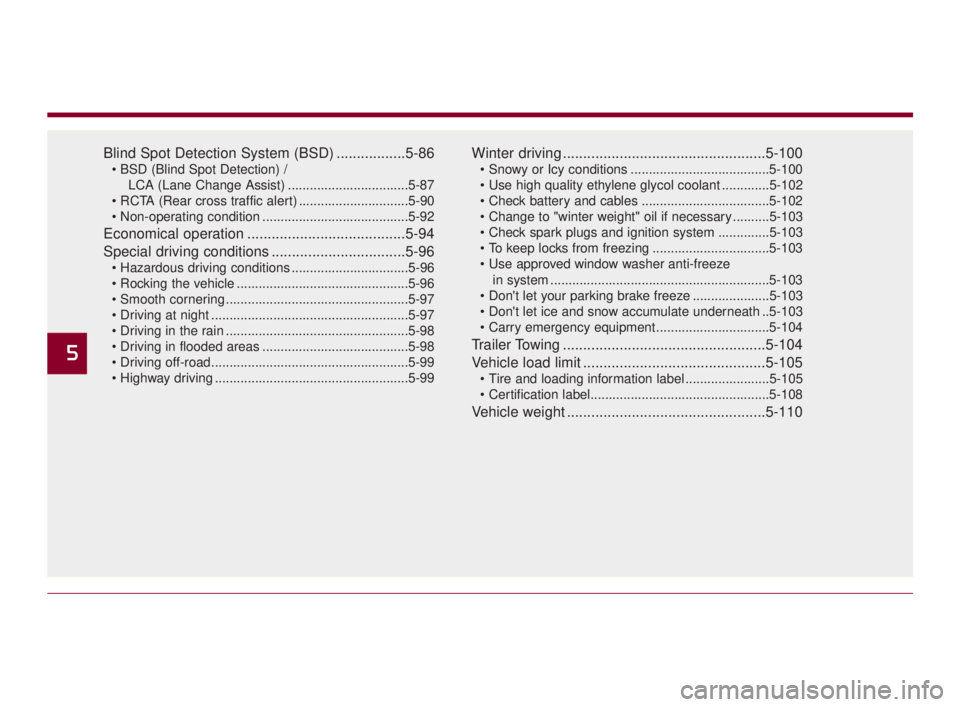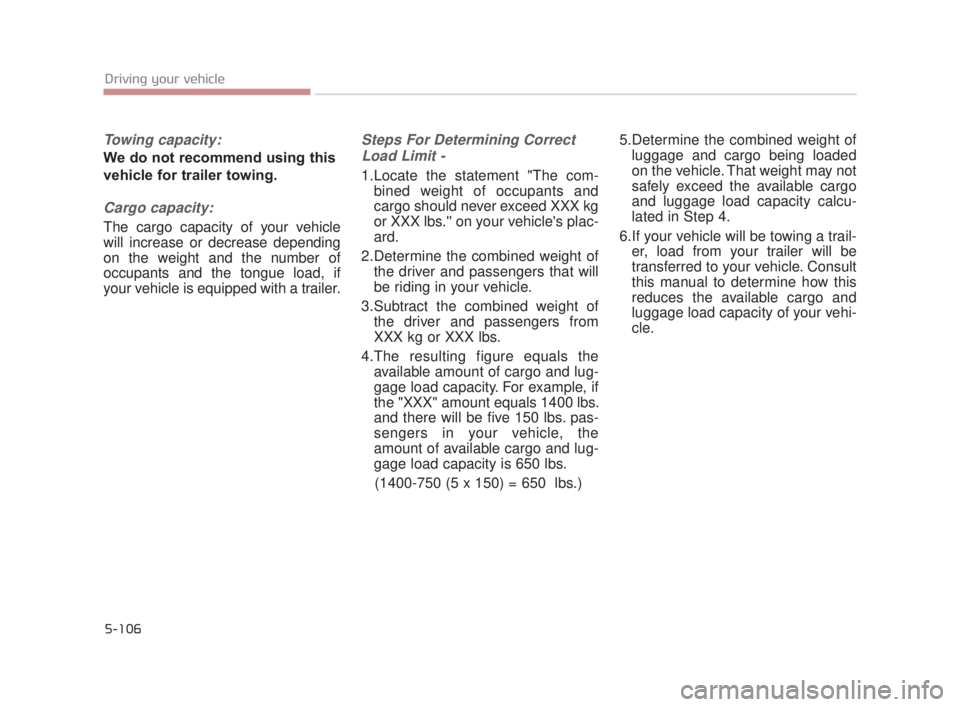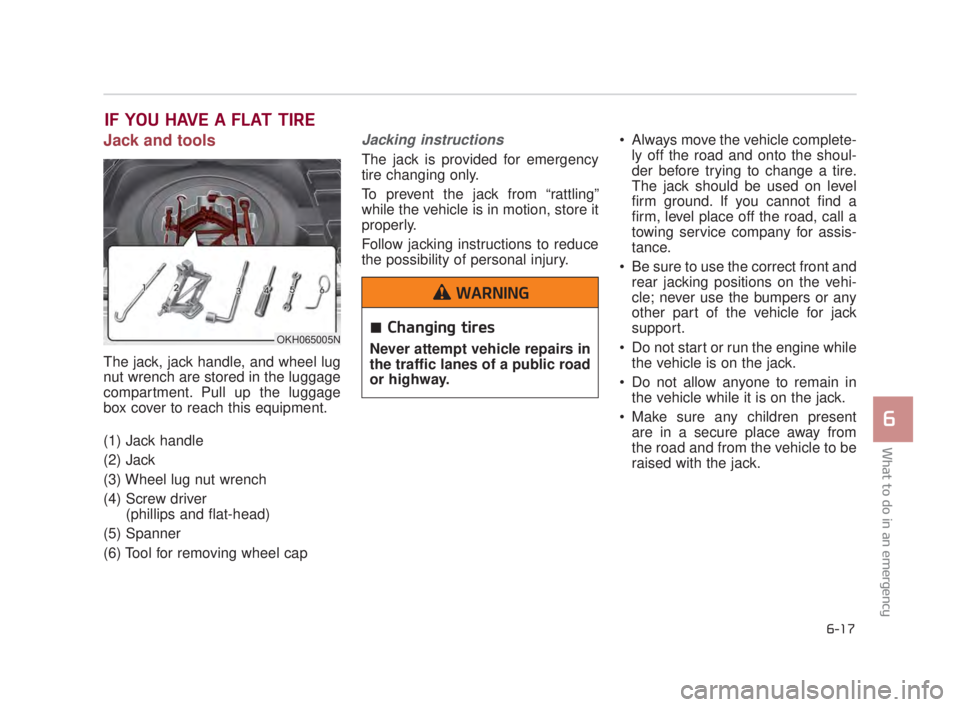Page 4 of 544

ii
1
2
3
4
5 6
7
8 I
IntroductionHow to use this manual / Fuel requirements / Vehicle break-in process /Vehicle data collection and event data recorders
Your vehicle at a glance
Exterior overview / Interior overview / Instrument panel overview / Engine compartment
Seat and safety features of your vehicle
Seats / Seat belts / Child restraint system / Air bag
Features of your vehicleSmart key / Door locks / Trunk / Windows / Hood / Fuel filler lid / Panoramic sunroof / Steering wheel / Mirrors /
Instrument cluster / Lighting / Wipers & Washers / Climate control system / Audio system / Etc.
Driving your vehicleBefore driving / Engine start/stop button / Transmission / Brake system /
Cruise control system / Advanced Smart Cruise Control system / Winter driving / Vehicle load limit / Etc.
What to do in an emergencyRoad warning / Emergency while driving / Emergency starting / Engine overheat / TPMS / Flat tire / Towing / Etc.
MaintenanceEngine compartment / Maintenance service / Engine oil / Engine coolant / Brake flui\
d / Washer fluid / Parking
brake / Air cleaner / Wiper blades / Battery / Tire and wheels / Fuses / Light bulbs / Etc.
Specifications, Consumer information and Reporting safety defects
Index
Table of contents
KH USA FOREWORD:2016 12/28/2016 3:34 PM Page 3
Page 267 of 544

Blind Spot Detection System (BSD) .................5-86
LCA (Lane Change Assist) .................................5-87
..............................5-90
........................................5-92
Economical operation .......................................5-94
Special driving conditions .................................5-96
................................5-96
...............................................5-96
..................................................5-97
......................................................5-97
..................................................5-98
........................................5-98
.....................................................5-99
Winter driving ..................................................5-100
......................................5-100
.............5-102
...................................5-102
..........5-103
..............5-103
................................5-103
Use approved window washer anti-freeze
in system ............................................................5-103
.....................5-103
..5-103
Trailer Towing ..................................................5-104
Vehicle load limit .............................................5-105
.......................5-105
Vehicle weight .................................................5-110
5
KH USA 5:2018 4/12/2017 9:58 AM Page 2
Page 369 of 544
5-104
Driving your vehicle
Carry emergency equipment
Depending on the severity of the
weather you should carry appropri-
ate emergency equipment. Some of
the items you may want to carry
include tire chains, tow straps or
chains, flashlight, emergency flares,
sand, a shovel, jumper cables, a win-
dow scraper, gloves, ground cloth,
coveralls, a blanket, etc.We do not recommend using this
vehicle for trailer towing.
TRAILER TOWING
KH USA 5:2018 4/12/2017 10:02 AM Page 104
Page 371 of 544

5-106
Driving your vehicle
Towing capacity:
We do not recommend using this
vehicle for trailer towing.
Cargo capacity:
The cargo capacity of your vehicle
will increase or decrease depending
on the weight and the number of
occupants and the tongue load, if
your vehicle is equipped with a trailer.
Steps For Determining CorrectLoad Limit -
1.Locate the statement "The com- bined weight of occupants and
cargo should never exceed XXX kg
or XXX lbs.'' on your vehicle's plac-
ard.
2.Determine the combined weight of the driver and passengers that will
be riding in your vehicle.
3.Subtract the combined weight of the driver and passengers from
XXX kg or XXX lbs.
4.The resulting figure equals the available amount of cargo and lug-
gage load capacity. For example, if
the "XXX" amount equals 1400 lbs.
and there will be five 150 lbs. pas-
sengers in your vehicle, the
amount of available cargo and lug-
gage load capacity is 650 lbs.
(1400-750 (5 x 150) = 650 lbs.) 5.Determine the combined weight of
luggage and cargo being loaded
on the vehicle. That weight may not
safely exceed the available cargo
and luggage load capacity calcu-
lated in Step 4.
6.If your vehicle will be towing a trail- er, load from your trailer will be
transferred to your vehicle. Consult
this manual to determine how this
reduces the available cargo and
luggage load capacity of your vehi-
cle.
KH USA 5:2018 4/12/2017 10:02 AM Page 106
Page 376 of 544

What to do in an emergency
Road warning......................................................6-2
...........................................6-2
In case of an emergency while driving ...............6-3
........6-3
....................................6-3
If the engine will not start ...................................6-4
......6-4
.....6-4
Emergency starting .............................................6-5
...........................................................6-8
If the engine overheats .......................................6-9
Tire Pressure Monitoring System (TPMS) ........6-11
.......................................6-13
malfunction indicator ...........................................6-14
...................................6-15
If you have a flat tire .........................................6-17
.......................................................6-17
.....................6-18
.......................................................6-19
..............................................................6-27
Towing ...............................................................6-28
........................................6-30
.................................................6-31
6
KH USA 6:2018 4/12/2017 10:21 AM Page 1
Page 380 of 544
EMERGENCY STARTING
Connect cables in numerical order
and disconnect in reverse order.
✽ NOTICE
Your vehicle has a battery in the
trunk compartment, but when you
jump start your vehicle, use the
jumper terminal in the engine com-
partment.
Jump starting
Jump starting can be dangerous if
done incorrectly. Therefore, to avoid
harm to yourself or damage to your
vehicle or battery, follow the jump
starting procedures. If in doubt, we
strongly recommend that you have a
competent technician or towing serv-
ice jump start your vehicle.
What to do in an emergency
6
6-5
OKH063024N
12 Volt Push/Pull Start
Use only a 12-volt jumper sys-
tem. You can damage a 12-volt
starting motor, ignition system,
and other electrical parts
beyond repair by use of a 24-volt
power supply (either two 12-volt
batteries in series or a 24-volt
motor generator set).
CAUTION
KH USA 6:2018 4/12/2017 10:21 AM Page 5
Page 392 of 544

What to do in an emergency
6
6-17
IF YOU HAVE A FLAT TIRE
Jack and tools
The jack, jack handle, and wheel lug
nut wrench are stored in the luggage
compartment. Pull up the luggage
box cover to reach this equipment.
(1) Jack handle
(2) Jack
(3) Wheel lug nut wrench
(4) Screw driver (phillips and flat-head)
(5) Spanner
(6) Tool for removing wheel cap
Jacking instructions
The jack is provided for emergency
tire changing only.
To prevent the jack from “rattling”
while the vehicle is in motion, store it
properly.
Follow jacking instructions to reduce
the possibility of personal injury. Always move the vehicle complete-
ly off the road and onto the shoul-
der before trying to change a tire.
The jack should be used on level
firm ground. If you cannot find a
firm, level place off the road, call a
towing service company for assis-
tance.
Be sure to use the correct front and rear jacking positions on the vehi-
cle; never use the bumpers or any
other part of the vehicle for jack
support.
Do not start or run the engine while the vehicle is on the jack.
Do not allow anyone to remain in the vehicle while it is on the jack.
Make sure any children present are in a secure place away from
the road and from the vehicle to be
raised with the jack.
OKH065005NChanging tires
Never attempt vehicle repairs in
the traffic lanes of a public road
or highway.
WARNING
KH USA 6:2018 4/12/2017 10:21 AM Page 17
Page 403 of 544

6-28
What to do in an emergency
TOWING
Towing service
If emergency towing is necessary,
we recommend having it done by an
authorized K900 Kia dealer or a
commercial tow-truck service.
Proper lifting and towing procedures
are necessary to prevent damage to
the vehicle. The use of wheel dollies
or flatbed is recommended.It is acceptable to tow the vehicle
with the front wheels on the ground
(without dollies) and the rear wheels
off the ground.
If any of the loaded wheels or sus-
pension components are damaged
or the vehicle is being towed with the
rear wheels on the ground, use a
towing dolly under the rear wheels.
When being towed by a commercial
tow truck and wheel dollies are not
used, the rear of the vehicle should
always be lifted, not the front.
Ensure any metal parts on the tie-
down straps do not contact painted
surfaces or the face of the wheels.
Do not place straps over the body panels or through the wheels.
OKH064014N
A
B
C dolly
OKH065027N
Attaching straps to the chasis,
suspension or other parts of
the body can cause damage.
CAUTION
Side and curtain air bag
If your vehicle is equipped with
side and curtain air bag, set the
ignition switch to LOCK or ACC
position when the vehicle is
being towed. The side and cur-
tain air bag may deploy when
the ignitions is ON, and the
rollover sensor detects the situ-
ation as a rollover.
WARNING
KH USA 6:2018 4/12/2017 10:22 AM Page 28